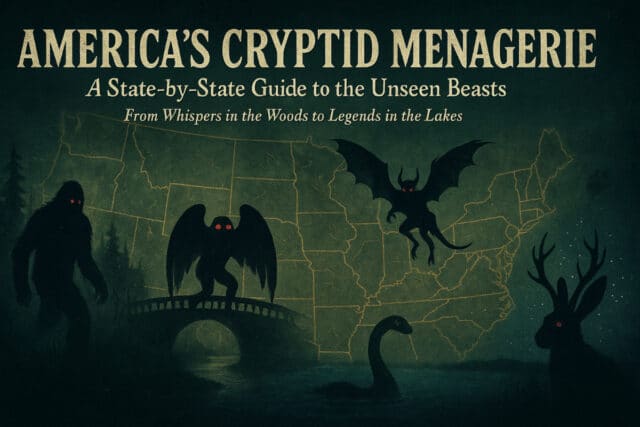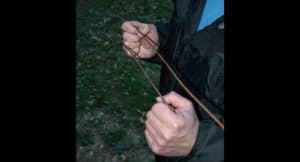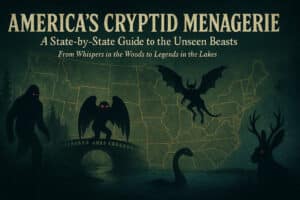
From the shadowy swamps of the South to the misty forests of the Pacific Northwest, every corner of the United States harbors its own whisper of the unknown. Cryptids—those elusive creatures teetering on the edge of folklore, eyewitness accounts, and outright mystery—have captivated imaginations for centuries.
Whether born from Native American legends, frontier tall tales, or modern sightings backed by blurry photos and frantic reports, these beings remind us that the map of America is dotted not just with cities and rivers, but with riddles that defy explanation.
In this guide, we’ve scoured the lore of all 50 states to spotlight one iconic cryptid per state: a pale screamer in Alabama, a shape-shifting otter-man in Alaska, and everything in between. Prepare to question what’s lurking just beyond the treeline…
Alabama - White Thang
A pale, white-furred humanoid creature reported throughout Alabama since the early 1900s, particularly in Morgan, Etowah, and Jefferson counties. Standing seven to eight feet tall with glowing red eyes, the White Thang is described as moving with incredible speed and emitting a terrifying scream. Unlike typical Bigfoot reports, this cryptid is distinguished by its white coloration and particularly aggressive behavior toward those who encounter it.
Alaska - Kushtaka
A shape-shifting creature from Tlingit and Tsimshian mythology, the Kushtaka or “land otter man” is said to inhabit the forests and waters of Southeast Alaska. This cryptid is believed to lure unsuspecting travelers to their doom, often by imitating the cries of babies or women in distress. Described as either humanoid otters or beings that can shift between human and otter form, Kushtaka are considered omens of death in indigenous traditions.
Arizona - Mogollon Monster
Arizona‘s answer to Bigfoot, the Mogollon Monster is a seven-foot-tall, bipedal creature covered in long black or reddish-brown hair, reported primarily in the Mogollon Rim region. First documented in 1903 in a local newspaper, this cryptid is known for its terrible odor and intimidating presence. Witnesses describe it as more aggressive than typical Bigfoot encounters, with numerous reports of the creature charging at hikers and campers.
* Check out some of the other names for Bigfoot from around the world.
Arkansas - Fouke Monster
Made famous by the 1972 documentary-style film “The Legend of Boggy Creek,” the Fouke Monster is a three-toed, ape-like creature reported near the town of Fouke in southern Arkansas. Standing between seven and ten feet tall and weighing an estimated 250-300 pounds, this cryptid gained national attention following a series of encounters in the early 1970s. The creature is characterized by its distinctive three-toed footprints and blood-curdling screams.
California - Tahoe Tessie
A large serpentine creature said to inhabit the depths of Lake Tahoe, Tessie has been part of local Washoe tribe legends for centuries before gaining wider attention in the 1950s. Described as between 10 and 80 feet long with a serpentine body and humps protruding from the water, Tessie is California’s most famous lake monster. Sightings have been reported by numerous credible witnesses, including law enforcement officers and tourists.
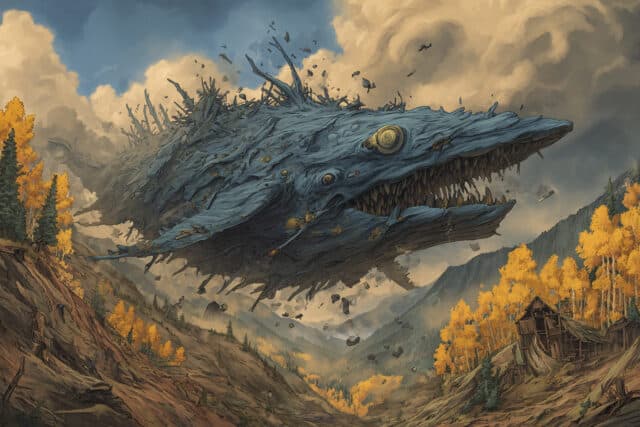
Colorado - Slide-Rock Bolter
A fantastical creature from Colorado mining folklore, the Slide-Rock Bolter is said to inhabit the steep slopes of the Rocky Mountains. This whale-like creature with a massive head and tiny fins supposedly slides down mountainsides on its slick belly to devour tourists and unwary travelers below. While clearly originating as a tall tale told by miners, the Slide-Rock Bolter remains Colorado’s most distinctive and whimsical cryptid.
Connecticut - Melon Heads
Small, humanoid creatures with bulbous heads said to inhabit the woods of Trumbull and Shelton, the Melon Heads are Connecticut’s most enduring urban legend. According to various accounts, these beings are either escaped mental patients, victims of medical experiments, or descendants of a cannibalistic colonial family. Described as child-sized with enlarged craniums and violent tendencies, they allegedly attack anyone who ventures too far into their forest territory.
Delaware - Selbyville Swamp Monster
A hulking, foul-smelling creature reported in the marshlands near Selbyville, Delaware, particularly during the 1960s. Described as standing seven feet tall, covered in matted hair, and possessing glowing eyes, this cryptid is known for raiding chicken coops and leaving behind massive footprints in the swamp. Local legend suggests the creature may inhabit the interconnected waterways between Delaware and Maryland.
Florida - Skunk Ape
Florida’s version of Bigfoot, the Skunk Ape is a large, bipedal ape-like creature named for its overwhelmingly foul odor, often compared to rotten eggs or skunk spray. Primarily reported in the swamps and forests of southern Florida, particularly the Everglades, this seven-foot-tall creature has reddish-brown hair and is said to be more comfortable in water than its Pacific Northwest cousin. The creature gained significant attention after the famous “Myakka photographs” surfaced in 2000.
Georgia - Altamaha-ha
Georgia’s legendary river monster, Altamaha-ha (nicknamed “Altie”) is said to inhabit the Altamaha River and surrounding waterways. Described as 20-30 feet long with a sturgeon-like snout, front flippers, and a horizontal tail fin, this cryptid has been reported by Native Americans for centuries and continues to be sighted today. Some cryptozoologists theorize it could be a surviving population of prehistoric marine reptiles trapped in the river system.
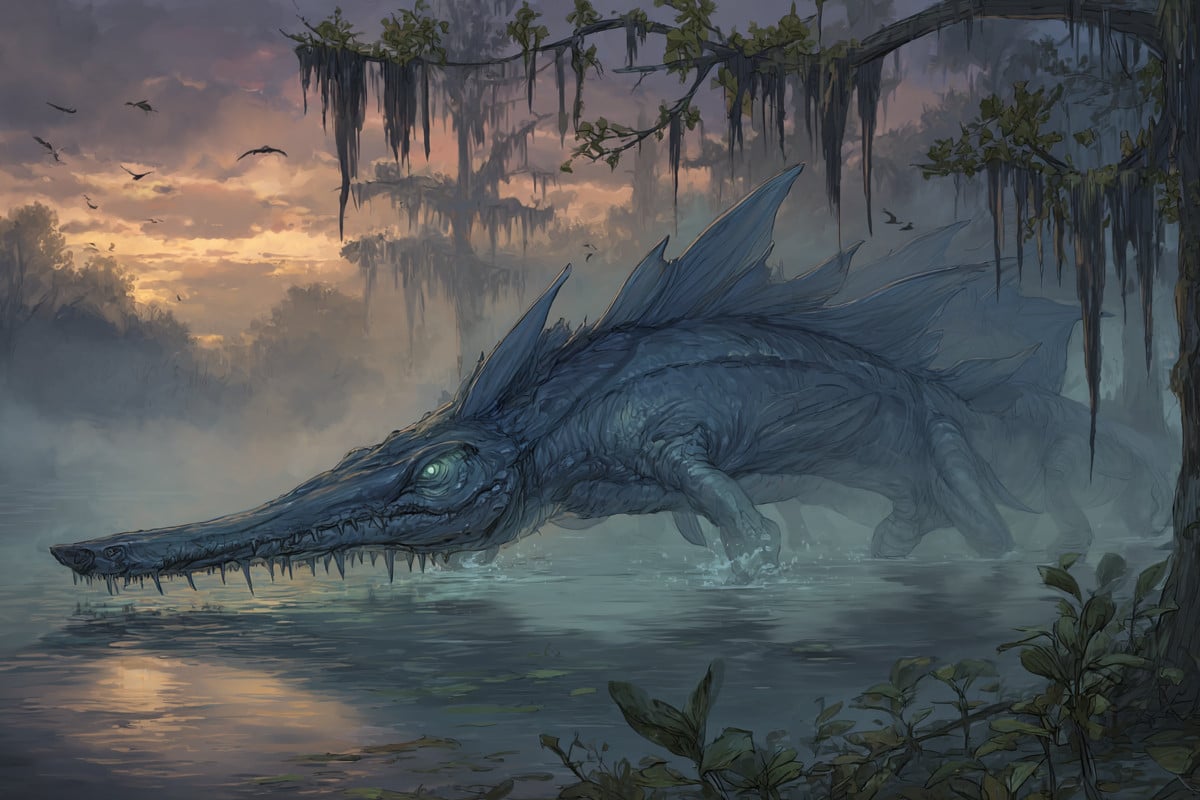
Hawaii - Menehune
Ancient Hawaiian mythology describes the Menehune as a race of small, dwarf-like people who lived in Hawaii before Polynesian settlers arrived. Standing two to three feet tall, these beings were said to be masterful craftsmen who built complex structures like fishponds and temples overnight. While traditionally considered folklore, some researchers point to unexplained ancient structures and continued modern sightings as evidence of their existence, making them Hawaii’s most famous cryptid.
Idaho - Sharlie
Idaho’s Loch Ness Monster, Sharlie inhabits Payette Lake near McCall and has been reported since the 1920s. Described as 30-35 feet long with a log-like or serpentine body, large shell, and dinosaur-like head, this cryptid is taken seriously enough that the Idaho State Legislature has considered protective legislation for it. Native American legends of the area speak of a creature called “Sljoo,” suggesting Sharlie may have ancient roots.
Illinois - Enfield Horror
A bizarre creature reported in Enfield, Illinois, during April 1973, described as having three legs, short gray arms with claws, reddish eyes, and standing four to five feet tall. The creature was reported to hop like a kangaroo and produced a hissing sound that terrified witnesses. Multiple credible sightings occurred over a two-week period, including an encounter where it allegedly attacked a young boy, leaving scratch marks on his body before hopping away into the darkness.
Indiana - Beast of Busco
A giant snapping turtle, nicknamed “Oscar,” reportedly living in Fulk Lake near Churubusco, Indiana. First sighted in 1898 and again causing a sensation in 1949, this cryptid was described as being the size of a dining room table with a shell measuring four to six feet across. The story captivated the nation in the late 1940s when locals attempted to drain the lake to capture the creature, though their efforts ultimately proved unsuccessful.
Iowa - Van Meter Visitor
A winged creature terrorized the small town of Van Meter, Iowa, over several nights in September 1903. Described as having a large pointed horn or beak that emitted a powerful blinding light, massive bat-like wings, and standing eight feet tall, this creature was encountered by multiple credible witnesses including the town doctor and banker. The beings allegedly emerged from an old mine shaft and have not been reliably reported since those original sightings.
I did a whole post on the Van Meter Monster of Iowa that you should check out.
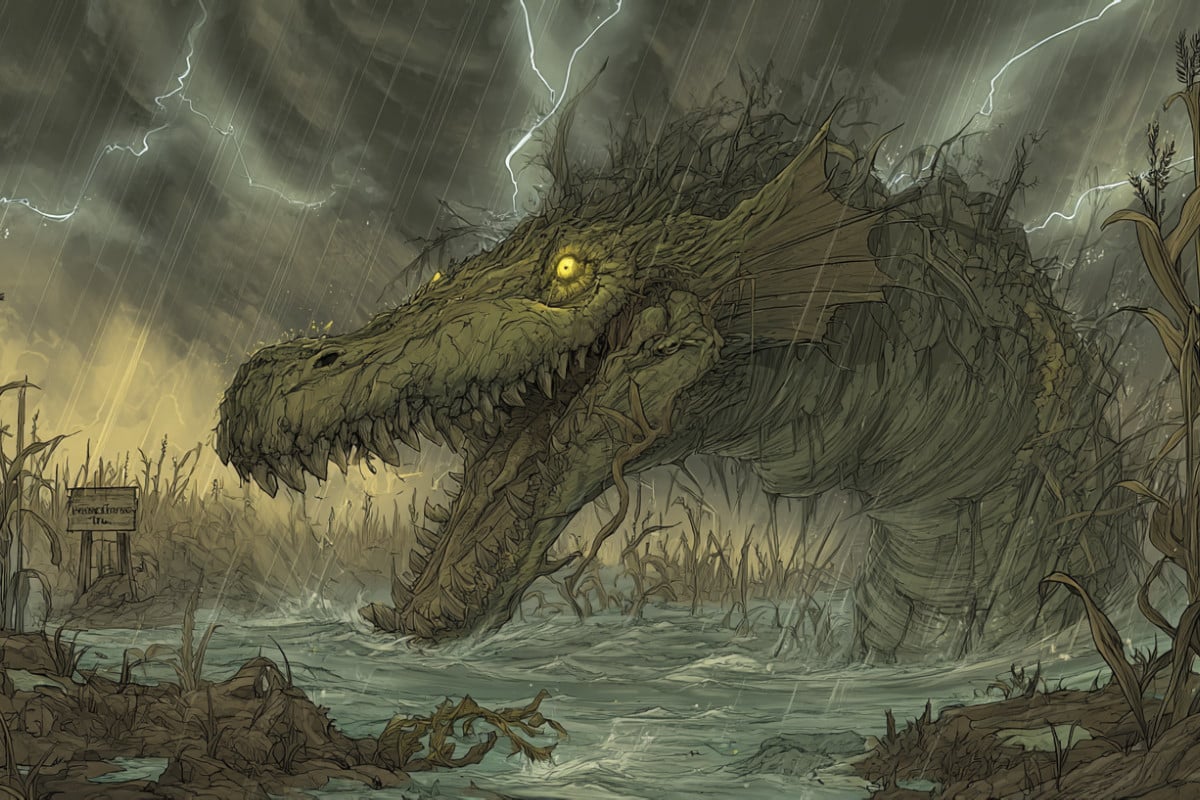
Kansas - Sinkhole Sam
A lake monster said to inhabit the sinkholes and underground water systems near Inman, Kansas, particularly in the 1950s. Described as 15 feet long with a serpentine body, alligator-like jaw, and muddy brown color, Sinkhole Sam allegedly emerged from flooded sinkholes to snatch livestock and pets. The creature was reportedly seen multiple times by farmers before disappearing, possibly into connected underground waterways.
Kentucky - Kelly-Hopkinsville Goblins
Small, silver-colored creatures with large heads, pointed ears, and claw-like hands that allegedly besieged a farmhouse near Kelly and Hopkinsville, Kentucky, in August 1955. During a terrifying multi-hour ordeal, the Sutton family and their friends encountered numerous floating, glowing beings that seemed impervious to gunfire. The incident became one of the most well-documented and credible close encounter cases in UFO history, though the creatures are often classified as cryptids rather than extraterrestrials.
Louisiana - Rougarou
A werewolf-like creature deeply rooted in French-Canadian and Cajun folklore, the Rougarou is said to prowl the bayous and swamps of Louisiana. Described as having a human body with a wolf or dog head, standing seven feet tall, and covered in fur, this creature was traditionally said to hunt those who break Lenten vows or misbehave. Modern sightings continue throughout southern Louisiana, with witnesses reporting glowing red eyes and an upright, bipedal stance.
Maine - Wessie
A giant snake-like creature reported in the Presumpscot River near Westbrook, Maine, particularly during summer 2016 when multiple witnesses photographed what appeared to be a massive serpent. Estimated at 10-15 feet long with a head the size of a basketball, Wessie captured local imagination and media attention. While some speculate it may be an escaped or released exotic pet anaconda, others believe it could be an undiscovered native species.
Maryland - Goatman
A hybrid creature described as having the head of a goat and the body of a man, armed with an axe and haunting the woods of Prince George’s County, Maryland, particularly near Beltsville and the Beltway. First reported in the 1950s and gaining prominence in the 1970s, the Goatman is said to attack cars, lovers’ lanes, and pets with savage brutality. Various origin stories claim it’s either the result of a genetic experiment gone wrong at a nearby USDA facility or an ancient demonic entity.
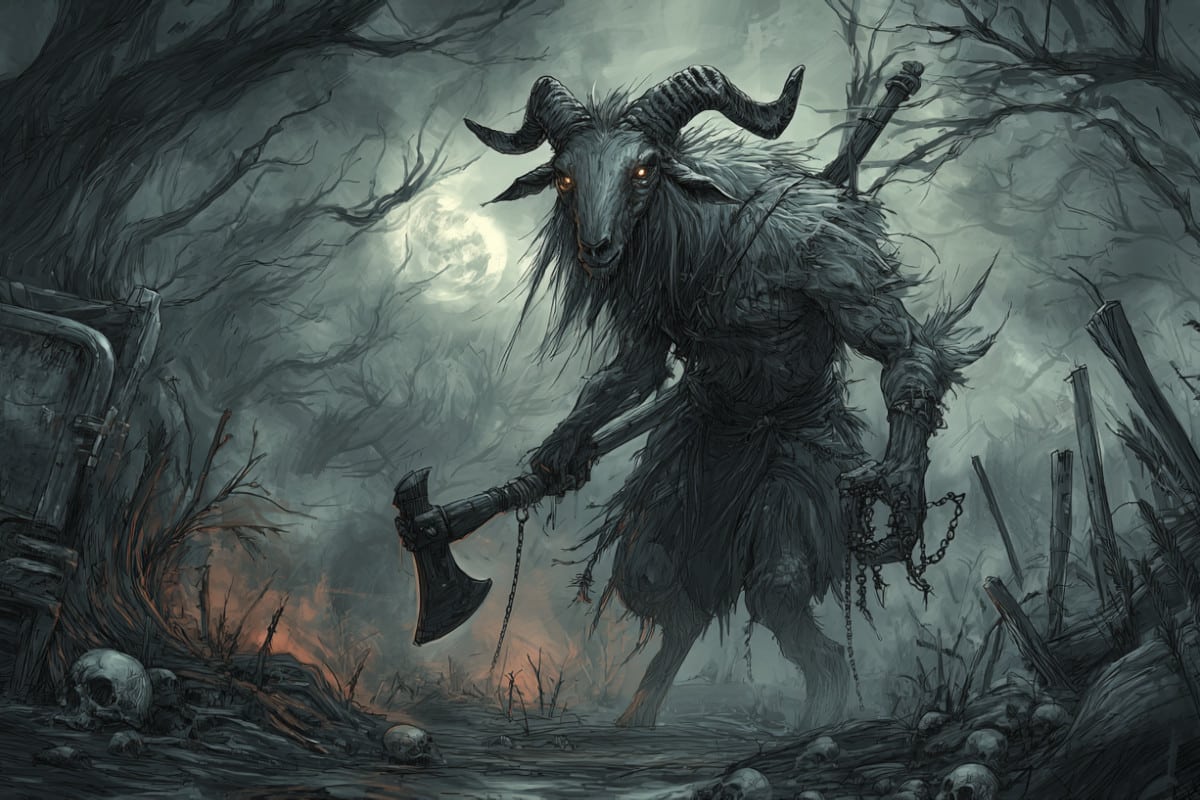
Massachusetts - Dover Demon
A bizarre creature sighted by multiple witnesses in Dover, Massachusetts, over a 25-hour period in April 1977. Described as having a large watermelon-shaped head, glowing orange eyes, long spindly fingers, and standing three to four feet tall with rough, hairless skin, this cryptid remains one of cryptozoology’s most peculiar cases. The witnesses were all teenagers considered credible, and their independent descriptions matched remarkably well despite having no contact with each other during the sightings.
There is a lot more to know about the Dover Demon Sightings so be sure to read the post I did all about this encounter!
Michigan - Michigan Dogman
A seven-foot-tall, bipedal canine creature with a wolf-like head, reported primarily in the northern forests of Michigan with sightings dating back to 1887. The creature supposedly appears in years ending in seven, according to popular legend, though sightings have been reported in other years as well. The Michigan Dogman gained widespread attention after a 1987 radio song by DJ Steve Cook became a surprise hit, inspiring numerous witnesses to come forward with their own encounters.
Minnesota - Wendigo
A malevolent supernatural creature from Algonquian folklore, the Wendigo is associated with winter, famine, and cannibalism in Minnesota’s northern forests. Described as a gaunt, skeletal figure standing 15 feet tall with glowing eyes, antlers, and an insatiable hunger for human flesh, the Wendigo embodies both physical monster and psychological phenomenon. Legend states that humans who resort to cannibalism become possessed and transform into these creatures, forever craving human meat.
Mississippi - Chatawa Monster
A massive, ape-like creature said to roam the swamps and forests of Pike County, Mississippi, near the Louisiana border, the Chatawa Monster is Mississippi’s answer to Bigfoot. According to legend, it escaped from a derailed circus train in the Tangipahoa swamp sometime in the early 20th century, releasing a ferocious half-man, half-ape hybrid into the dense woodlands of Homochitto National Forest. Described as a bipedal beast over seven feet tall with dark fur, powerful arms, and a menacing presence, it swings from trees and terrorizes locals with blood-curdling screams. Key sightings include a 1977 hunter’s confrontation with the creature over a squirrel, 1980 incidents of chicken coop raids leaving 14-inch footprints and a half-eaten calf, and a 2018 encounter by a highway patrol officer who saw it sprint across a field at dusk. Despite theories of escaped circus animals or hoaxes, ongoing reports of claw marks, livestock attacks, and trail cam footage keep the legend alive in Pike County folklore.
Missouri - Momo
The Missouri Monster, or “Momo,” is a large, three-toed Bigfoot-like creature with long, shaggy black hair and a pumpkin-shaped head, reported primarily near Louisiana, Missouri, in the early 1970s. Standing seven feet tall and emitting a terrible odor, Momo gained national attention after a 1972 incident where it allegedly carried a dead dog while approaching a home, terrifying local children. The creature was seen by numerous witnesses and tracked by law enforcement before disappearing into the woods.
Momo is still around though. Check out this report of Momo crossing a river.
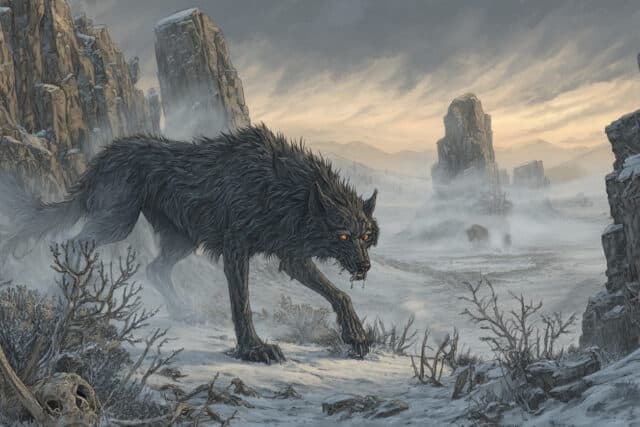
Montana - Shunka Warakin
A wolf-like creature from Native American legends meaning “carries off dogs,” the Shunka Warakin is described as having dark fur, a high back, and an unusual sloping profile unlike any known canine. One specimen was allegedly shot in Montana in 1886 and stuffed by a taxidermist, where it remained in a museum until mysteriously disappearing for decades before being rediscovered in 2007. The mounted creature displays unusual characteristics that have puzzled zoologists and cryptozoologists alike.
Nebraska - Alkali Lake Monster
A massive serpentine creature said to inhabit the alkaline lakes of western Nebraska, particularly in the late 1800s. Described as 40 feet long with a horn protruding from its head and alligator-like skin, this creature was reported by multiple settlers and cowboys during Nebraska’s frontier days. Some accounts describe the monster as aggressive, attacking livestock that came to the water’s edge, while Native American tribes in the region had long warned of dangerous spirits inhabiting these isolated lakes.
Nevada - Water Babies
Malevolent infant-like spirits from Paiute and Shoshone legends, Water Babies are said to inhabit springs, caves, and waterways throughout Nevada. These creatures produce crying sounds that lure unsuspecting victims to the water’s edge where they pull them under to drown. Described as having adult-like strength despite their small size, with wrinkled skin and sharp teeth, Water Babies serve as warnings to respect sacred water sources and remain deeply significant in Nevada’s indigenous cultures.
New Hampshire - Wood Devils
Large, aggressive ape-like creatures reported in the White Mountains region of New Hampshire since colonial times. Standing seven to nine feet tall and covered in dark hair, Wood Devils are distinguished from typical Bigfoot by their reportedly violent and territorial behavior. Historical accounts describe them attacking logging camps and pursuing hunters through the forest, leading some researchers to theorize they may be related to the Wendigo legends of neighboring regions.
New Jersey - Jersey Devil
Perhaps America’s most famous cryptid after Bigfoot, the Jersey Devil has haunted the Pine Barrens of New Jersey for over 280 years. Described as having a kangaroo-like body, bat wings, horse head, cloven hooves, and a forked tail, this creature allegedly was born as the 13th child of Mother Leeds in 1735 and transformed into a monster. Mass sightings occurred in 1909 when the creature was spotted across multiple counties, causing schools to close and factories to shut down in panic.
Lorem ipsum dolor sit amet, consectetur adipiscing elit. Ut elit tellus, luctus nec ullamcorper mattis, pulvinar dapibus leo.
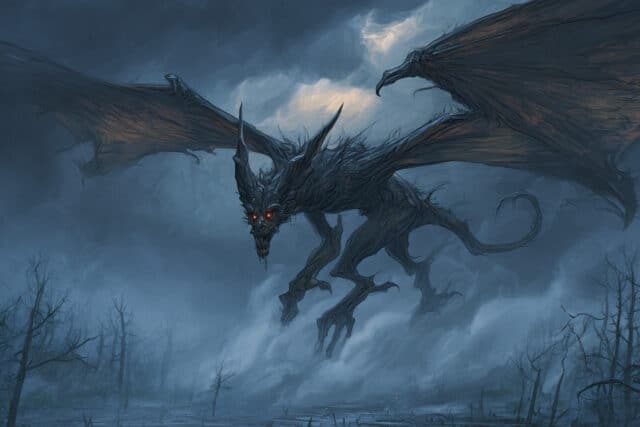
New Mexico - Skinwalker
A malevolent shapeshifting witch from Navajo tradition, the Yee Naaldlooshii or “Skinwalker” is said to wear the pelts of animals to transform into them, particularly wolves, coyotes, foxes, and owls. These beings are considered taboo to discuss within Navajo culture but have become widely known in New Mexico folklore. Skinwalkers are said to possess the ability to read thoughts, mimic voices, and bring harm to those they target, making them among the most feared cryptids in Native American tradition.
New York - Champ
The Lake Champlain Monster, nicknamed “Champ,” is a large aquatic cryptid inhabiting the waters between New York and Vermont. Described as 10-60 feet long with a serpentine body, humped back, and long neck, Champ has been reported for centuries, with Native American legends predating European settlement. The creature gained significant credibility through the famous Sandra Mansi photograph of 1977, which appears to show a long-necked creature emerging from the lake’s waters.
North Carolina - Beast of Bladenboro
A mysterious predator that terrorized Bladenboro, North Carolina, over two weeks in December 1953 and January 1954, killing and draining the blood from numerous dogs and other small animals. Described as cat-like, possibly resembling a cougar or panther, the Beast left distinctive marks on its victims and proved impossible to track despite intensive hunting efforts. The case remains unsolved, with theories ranging from an escaped exotic cat to an unknown indigenous predator.
North Dakota - Thunderbird
Enormous bird-like creatures from Plains Indian mythology reported occasionally in North Dakota skies, the Thunderbird is described as having wingspans of 20 feet or more with the ability to create thunder by flapping its wings. While Thunderbird legends exist across many Native American cultures, North Dakota sightings of massive birds that dwarf modern eagles continue sporadically. Some cryptozoologists speculate these could be surviving populations of prehistoric birds like teratorns, while others maintain the purely spiritual nature of these beings.
Ohio - Loveland Frog
A bipedal, humanoid frog creature standing about four feet tall, reported near Loveland, Ohio, particularly along the Little Miami River. First encountered by a businessman in 1955 who saw three of these creatures standing beneath a bridge, the Loveland Frog gained notoriety through two police sightings in March 1972. The creature is described as having leathery skin, webbed hands and feet, and the ability to move quickly on two legs before leaping into the river.
Find out all about the Loveland Frogmen in this post I wrote.
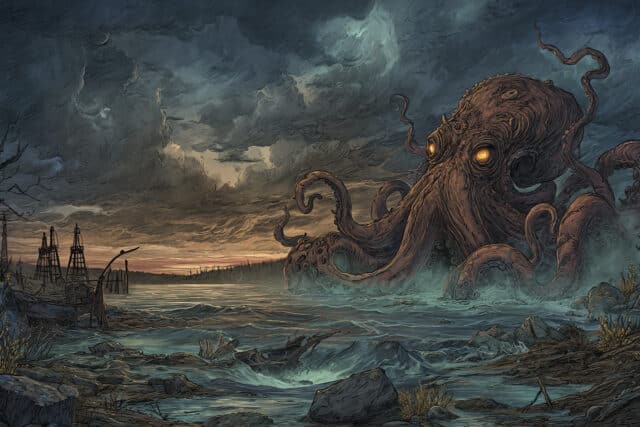
Oklahoma - Oklahoma Octopus
A freshwater octopus said to inhabit Oklahoma lakes, particularly Lake Thunderbird, Lake Oolagah, and Lake Tenkiller. Described as the size of a horse with reddish-brown color, this cryptid allegedly drowns swimmers and fishermen by pulling them beneath the surface with its powerful tentacles. While no octopus species is known to inhabit freshwater environments, disappearances in these lakes and alleged encounters have kept the legend alive, making it Oklahoma’s most unique cryptid.
Oregon - Colossal Claude
A massive sea serpent reported along the Oregon coast and in the Columbia River, particularly near the mouth where it meets the Pacific Ocean. Described as 40 feet long with a large shell-like back, horse-like head, and prominent eyes, Colossal Claude has been spotted by numerous fishing vessels and Coast Guard personnel since the 1930s. The creature’s name comes from a famous 1934 sighting by the crew of the Columbia River lightship, who observed it at close range.
Pennsylvania - Squonk
A peculiar cryptid unique to Pennsylvania folklore, the Squonk is described as a small, warty creature that constantly weeps due to the ugliness of its own appearance, leaving a trail of tears wherever it goes. Legend states that when captured, the Squonk dissolves into a pool of tears and bubbles, making it impossible to keep as evidence. While likely originating as a lumberjack tall tale, the Squonk has become Pennsylvania‘s most beloved and distinctive cryptid, representing the whimsical side of American cryptozoology.
Rhode Island - Mercy Brown Vampire
While not a creature in the traditional cryptid sense, the vampire panic surrounding Mercy Lena Brown in 1892 Exeter, Rhode Island, represents the state’s most famous supernatural phenomenon. After tuberculosis ravaged the Brown family, villagers exhumed Mercy’s body, found it “unnaturally preserved,” and burned her heart, mixing the ashes into a tonic for her sick brother. The case influenced Bram Stoker’s Dracula and represents America’s last documented vampire hunt, making it Rhode Island’s most significant contribution to cryptid lore.
South Carolina - Lizard Man of Scape Ore Swamp
A seven-foot-tall, bipedal reptilian humanoid with green scaly skin, glowing red eyes, and three-fingered claws, reported near Bishopville, South Carolina, since 1988. The creature gained national attention when 17-year-old Christopher Davis reported being chased by it after changing a tire near Scape Ore Swamp. Physical evidence including damaged vehicles with claw marks and unusual three-toed footprints have lent credibility to the accounts, making the Lizard Man one of America’s most famous cryptids.
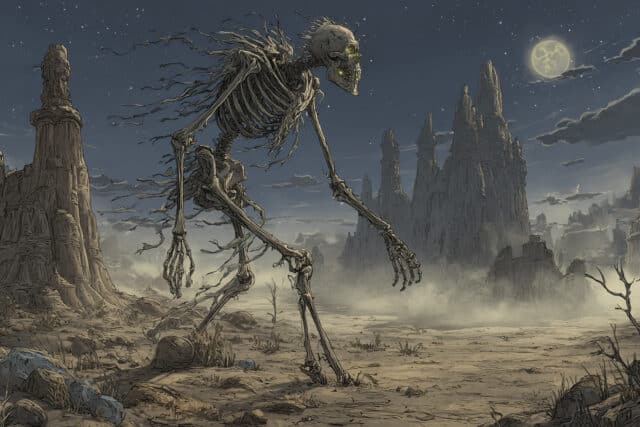
South Dakota - Taku-He (Walking Skeleton)
A terrifying creature from Sioux legend described as an animated human skeleton that walks through the night, its bones clicking together as it moves. Reported primarily in the Badlands region of South Dakota, the Taku-He is said to chase those who encounter it, with its rattling bones growing louder as it approaches. Those who see the Walking Skeleton are warned never to look back while fleeing, as doing so invites the creature to pursue them relentlessly.
Tennessee - Wampus Cat
A six-legged panther-like creature from Cherokee legend, the Wampus Cat is said to prowl the mountains of eastern Tennessee. According to traditional stories, it was once a woman who spied on sacred male ceremonies while wearing a cougar skin, and was transformed as punishment into a half-woman, half-cat creature. The Wampus Cat is described as having yellow eyes that glow in darkness and moving with supernatural speed, serving as both protector of the forest and omen of misfortune.
Texas - Chupacabra
A vampiric creature that attacks livestock, particularly goats, draining their blood through puncture wounds, first reported in Texas in the mid-1990s. The Texas version is typically described as a hairless, gray-skinned quadruped resembling a diseased canine, distinct from Puerto Rico’s original bipedal reptilian description. Numerous cattle mutilations and alleged Chupacabra bodies (often identified as mange-ridden coyotes) have made Texas the creature’s primary North American habitat and epicenter for ongoing sightings.
Utah - Bear Lake Monster
A massive serpentine creature inhabiting Bear Lake on the Utah-Idaho border, described as being 20-40 feet long with small legs or flippers and crocodile-like jaws. First reported extensively in the 1860s by Mormon settlers and visiting Native American tribes, the monster allegedly swam alongside boats and occasionally lunged at swimmers. While some believe the stories were fabricated by a local journalist to attract tourists, sightings continued throughout the 20th century, making it Utah’s most enduring cryptid.
Vermont - Pigman
A grotesque hybrid creature said to haunt the woods near Northfield, Vermont, particularly around the old Northfield Pigman Farm. Described as having a man’s body with a pig’s head or face, this cryptid allegedly escaped from a genetic experiment at a local farm or mental institution. Reports describe it as aggressive, making grunting and squealing sounds while chasing trespassers through the forest. The legend has become a popular dare among local teenagers who venture to the abandoned farm at night.
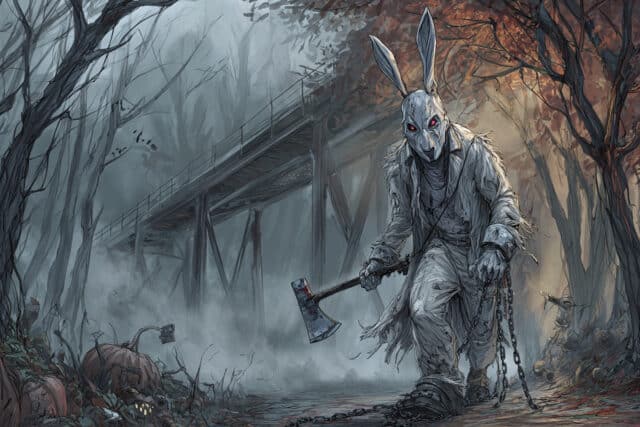
Virginia - Bunny Man
An axe-wielding figure dressed in a bunny costume who allegedly haunts Fairfax County, Virginia, particularly near the Bunny Man Bridge (Colchester Overpass). Based on real 1970 incidents where someone in a rabbit costume threatened people with an axe and threw a hatchet at cars, the legend has grown to include claims of a deranged man who escaped from an asylum, murdered fellow patients, and now hunts the area dressed in a rabbit suit. The bridge has become a pilgrimage site for thrill-seekers, especially around Halloween.
Washington - Bigfoot
A prominent cryptid throughout North America, Bigfoot (or Sasquatch) is a large bipedal ape-like creature who is associated with the Pacific Northwest, most notably Washington. Originating from the 1950s, Bigfoot has become big in American pop culture with “evidence” of its existence, such as the famous frame from the Patterson-Gimlin film, becoming a sort of staple in the world of cryptozoology. Sightings of Bigfoot have been recorded in every single state, with many museums and attractions being built to display their discoveries.
West Virginia - Mothman
A winged humanoid creature with glowing red eyes, standing six to seven feet tall, reported in Point Pleasant, West Virginia, from 1966-1967. The Mothman is described as having large wings spanning 10 feet, no discernible head, and the ability to fly at tremendous speeds. The creature’s appearances culminated with the tragic collapse of the Silver Bridge in December 1967, leading many to believe Mothman was either a harbinger of disaster or somehow connected to the catastrophe. The legend inspired books, films, and an annual festival.
Wisconsin - Hodag
A horned, dragon-like creature with a spiky back, sharp claws, and a long tail, first “discovered” near Rhinelander, Wisconsin, in 1893 by lumber surveyor Eugene Shepard. While originally created as a hoax using wood and animal hides to prank gullible city folk, the Hodag became Wisconsin’s beloved state cryptid. Described as being seven feet long and three feet tall with “the head of a frog, the grinning face of a giant elephant, thick short legs, and a long tail,” the Hodag has been enthusiastically adopted as Rhinelander’s official symbol.
Wyoming - Jackalope
Perhaps America’s most whimsical cryptid, the Jackalope is a jackrabbit with antelope horns or deer antlers, said to inhabit the prairies and mountains of Wyoming. First “discovered” in Douglas, Wyoming, in the 1930s by taxidermist brothers Douglas and Ralph Herrick, the Jackalope quickly became a staple of Western American folklore. Legend claims these creatures can mimic human voices, prefer whiskey, and are extremely dangerous when cornered. Douglas remains the “Jackalope Capital of the World” and issues official hunting licenses for the creature.
…as the eerie echoes of Wyoming’s jackalope fade into the night, one truth lingers: America’s cryptids aren’t just monsters—they’re mirrors to our wildest fears, oldest stories, and unquenched curiosity. From indigenous warnings whispered around campfires to blurry trail cam snaps in the dead of night, these elusive beings remind us that the frontier of the unknown is as vast as the continent itself. Who knows? The next sighting could rewrite the map.
Spotted a cryptid we overlooked, or have your own spine-tingling tale from the backroads? Let us know—send your reports to Reports@ParaRational.com. We might just feature it in the next edition!

